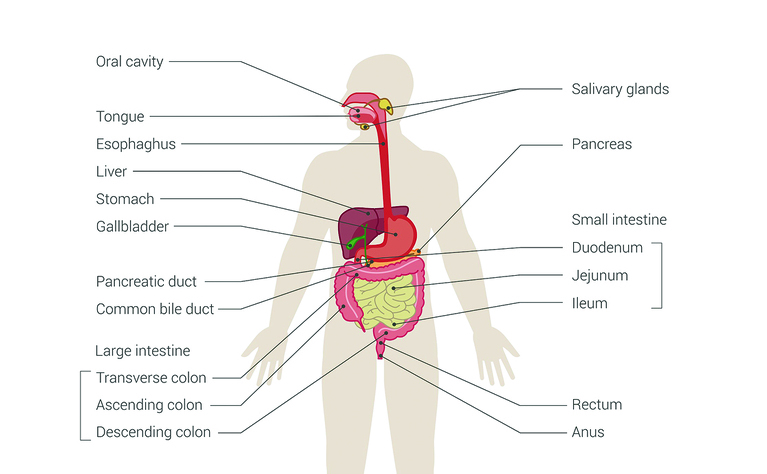Do you know how the digestive system works? Find out in this article...
Crohn’s disease can affect any part of your digestive system. But do you know all of the bits of the digestive system and how they work? Here we take a look at it.
Your digestive system turns the food you eat into nutrients which the body then uses for energy, growth and repair. It is made up of lots of different parts which all do different things. The digestive system is sometimes called other names like digestive tract and GI system. You may hear your doctor calling it these things.

Digestion starts in the mouth before you have even taken the first bite of a meal. When you smell, see or think about tasty food your mouth will often start salivating (making saliva which is the wet substance in your mouth). When you take your first bite this saliva mixes with the food to help break it down so that your body can absorb it. Chewing the food also helps this process and your tongue moves the food around to get it to your teeth and mix it with the saliva.
After leaving the mouth the food travels through your throat (also known as the pharynx) towards the esophagus.
The esophagus is a muscular tube which connects the throat and the stomach. It is about 25cms long and pushes food down towards your stomach using contractions. A contraction is when the muscles get bigger and small to squeeze the food through. It takes 2-3 seconds for the food to move through the esophagus. Just before the esophagus meets the stomach there is a valve which is designed to stop food from passing back upwards.
The stomach is an organ and it has strong walls made of muscle. When the food reaches the stomach it is mixed with acid and something called enzymes which break down the food. They also try to kill bacteria that may be in the food. The stomach has strong wall muscles which contract to help turn the food into a liquid or paste.
After leaving the stomach the food reaches the small intestine. The small intestine is a long tube (more than 6m long and 3.5-5cms wide) which is squashed up in the tummy. It is made up of three segments - the duodenum, the jejunum and the ileum.
In the small intestine the food continues to be broken down and more contractions help to move the food through. The job of the duodenum is mostly to continue the process of breaking down the food, while the jejunum and ileum are mostly responsible for absorbing water and nutrients into the bloodstream. Around 90% of digestion and absorption takes place in your small intestine. This means that if you have Crohn’s disease in your small intestine you may have trouble absorbing all the nutrients and liquid from your food and drink. Food can spend around 4 hours in the small bowel. Once the small intestine has absorbed all the nutrients any leftover food moves through to the colon.
The colon is a wide (around 7-10cms) muscle tube that runs between the cecum (the first part of the colon) to the top of the rectum. It is around 1.5m in length. The parts of the colon are the cecum (the beginning of the colon) the ascending (right) colon, the transverse (across) colon, the descending (left) colon and the sigmoid colon - which connects to the rectum. Food waste is moved through the colon by even more contractions and as it passes through more water and nutrients are absorbed so that a poo is formed. This poo (stool) is then stored in the sigmoid colon until the body empties it into the rectum. It normally takes around 36 hours for a stool to get through to the end of the colon. However, if you have active Crohn’s disease this can happen a lot quicker. A stool is mostly made up of food debris and bacteria. When the descending colon becomes full it empties the contents into the rectum.
You may hear doctors talking about the large intestine. This is the word used for the colon, rectum and anus together.
The rectum connects the colon to the anus. It is around 20cm long and holds the poo until your body is ready to push it out. When a poo (or gas) reaches the rectum sensors send a message to the brain to let it know that there is something in the rectum. Muscles, known as sphincters, hold in the poo until a message is sent from the brain to let the rectum know that the poo can be released (hopefully into a toilet!). When this happens the muscles relax, releasing the contents.
The anus is made up of different muscles that work together to stop a poo coming out until you are ready.
